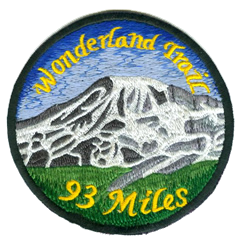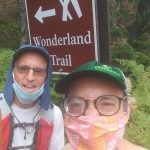
I wrote about the Wonderland Trail in April, the 93-mile loop encircling Mount Rainier, and hinted that I’d soon return with more stories and tips—here they are! If you don’t fancy yourself a sleep-on-the-ground backpacker, fear not, I’ll share my favorite day hikes on the Wonderland Trail, too.
Valerie always feared that Big Blue would be the death of me. I led youth outdoor work camps and trail crews in national parks and forests between 1976 and 1994, and the work often involved carrying heavy loads. Heck, I once had the privilege of staggering under the weight of a replacement engine block for a mini-excavator, strapped to a pack frame.
To accommodate the loads, I purchased the largest-volume backpack I could find, an enormous sack roomy enough to carry a den of Cub Scouts. Made by Hine-Snowbridge of Boulder, Colorado, its internal frame and Cordura nylon fabric were 1970s state-of-the-art. Two strap-on pockets held a week’s groceries. Spartan padding on the shoulder straps and waist belt ensured that lugging the load would be anything but a good time.
We were too young, strong, and full of hubris to weigh our gear back then, but crewmates often had to hoist Big Blue onto my back. Down the trail I wobbled, soon coming to appreciate the old adage, “You can always tell a fool by the size of his pack.”

And Valerie’s fear? She worried that Big Blue would make her a widow, afraid that she’d come around a bend in the trail to find me squashed like an ant, arms and legs splayed outward under the massive pack. It never happened, but I learned a few things along the way.
By the time I turned 40, I knew I’d need to change my backpacking ways if I wanted to save my knees and hike into the sunset of retirement. I discovered that there were no prizes for schlepping the heaviest pack, and that carrying less weight meant more enjoyment. I retired Big Blue and bought smaller packs. Lightweight gear flooded the market, so I bought lighter sleeping bags and tents. These days, I sleep under an ultralight tarp that Valerie christened “The Bearrito,” for fear that a black bear will roll me up in it and eat me for dinner. Ryan Zimmer, a student of mine at Evergreen and fresh off the Pacific Crest Trail, provided loads of tips and encouragement. Mike Clelland’s Ultralight Backpackin’ Tips taught me the foolishness of cutting the handle off a toothbrush to conserve weight if I insist on carrying a 5-pound salami log. I started planning menus based on calories per ounce of food, so luxuries like bagels, cream cheese, and processed meats were out. Nut butters, nuts, and chips joined the menu. I bought a kitchen scale, weighed everything, and recorded the data on spreadsheets.
Even the small items add up. Prior to my fifth Wonderland Trail hike in 2017, I bought a pair of Dr. Scholl’s inserts to provide extra cushion for my sore feet. As I replaced the stock insoles in my trail runners, the Dr. Scholl’s felt heavier. Curious, I weighed both pairs and did a little math. I calculated my number of steps per mile and multiplied it by the trail’s 93 miles. I was flabbergasted—the numbers told me that by wearing the Scholl’s inserts, I’d lift an additional 22,000 pounds over the course of my 6-day hike. Dr. Scholl stayed home.
Besides the weight carried on a hike, the other key to success is proper conditioning. My mountaineering friends say, “You get into shape to climb mountains by climbing mountains.” This means that similar activities like hiking up and down hills, walking stairs, or using a Stair Climber at the gym, all with packs and weight, help prepare for a climb. The same holds true for hiking or backpacking, especially training hikes with frequent grade changes.
The linchpin for a Wonderland Trail thru-hike (and all overnight stays in the backcountry at Mount Rainier) is a backcountry permit. These are available online, but are legendarily difficult to secure, especially if you request a specific itinerary and have rigid dates. My secret weapon is to take advantage of the park policy to hold 30 percent of permits for walk-up reservations, for hikes beginning that day or the next. I set up a camp chair outside a ranger station or Wilderness Information Center an hour before it opens, eat my breakfast, and wait. That puts me at or near the front of the line and practically guarantees a permit.
Most WT thru-hikers begin at Longmire, travel clockwise (it has something to do with less elevation gain in that direction, but I prefer going counter-clockwise), and take a week or more. Most also take advantage of one to three food drops at various locations on the trail, lightening their loads. Some folks backpack the trail in sections, taking multiple seasons to complete the loop. Any first-timers serious about the Wonderland Trail should get a copy of Tami Asars’ Hiking the Wonderland Trail or any of the other guidebooks.
If backpacking the Wonderland Trail doesn’t appeal to you, you can explore it with day hikes. Loop hikes are tougher to pull off, but out-and-back hikes are plentiful and vary widely in mileage and scenery. An old standby of mine is to depart Sunrise and hike to Skyscraper Pass, about 7 miles roundtrip, a fabulous hike thru subalpine habitat with a great opportunity to see mountain goats. A side trip up Skyscraper Mountain adds to the experience.

For me, the Wonderland Trail’s Grand Champion of day hikes requires a bit of driving and a car drop-off, but traverses some of the park’s most incredible scenery. Start super-early and park a car at Box Canyon on the Stevens Canyon Road, your hike’s endpoint. Drive to the Fryingpan Creek trailhead on the White River road and hike thru Summerland, up and over Panhandle Gap, down to Indian Bar, and out to Box Canyon. It’s about 17 miles with plenty of elevation gain and loss, but it’s a day you’ll always treasure. When Dimitri and I hiked Fryingpan to Box Canyon last summer, we encountered the recently returned wolverine and its two kits—a super-lucky, once-in-a-lifetime sighting!
Whether you section hike, day hike or thru-hike the Wonderland Trail, there’s plenty of trail to wander and expand your sense of wonder. And if hiking isn’t exactly your game, let’s just get outside and breathe deeply! I’m itching to get back into the high country, and looking forward to visiting some of my old haunts. In fact, to take full advantage of the summer months, I’m taking a break from publishing a blog until October—I’ll catch up with you then. In the meantime, keep your boots dry and your spirits high.


